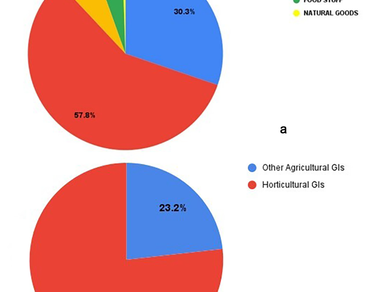Horticultural geographical indications of India: botanical aspect
Singh Garvita, Sharma Kirti, Dawer Sakshi, Rana Shweta, Soni Renu, Singh Varsha K., Sinha Rajeshwar P.
Review Articles | Published: 01 August, 2023
First Page: 803
Last Page: 817
Views: 3555
Keywords: Botanical details, Family, State, Horticulture, Registered GIs
Abstract
Geographical Indication (GI) is an intellectual property (IP) tool that aids in establishing a link between the product, its place of origin and maintaining multi -functionality between rural areas and market place along with conservation of traditional knowledge. The GI act prevents third party intervention and market exploitation of the natural resources and their by-products. Strict enforcement of laws and increase in awareness among producers is needed so that the producers confer the real benefit rather than it being garnered by other intermediaries. In this paper, we intend to document the registered GIs (excluding advertised GIs) from horticulture in India till May, 2021 with emphasis on their year and characteristics. Furthermore, it also focuses on the botanical details of the GI product including its botanical name, family, number of cotyledons, and parts used.

References
Babu N, Srivastava SK, Agarwal S (2013) Traditional storage practices of spices and condiments in Odisha. Indian J Tradit Knowl 12(3):518–523. http://hdl.handle.net/123456789/19438
Bhunia GS (2019) Horticulture development in India: issues and scenario of space technology. World J Agric Soil Sci 3(1):1–5
Bowen S, Zapata AV (2009) Geographical indications, terroir, and socioeconomic and ecological sustainability: the case of tequila. J Rural Stud 25(1):108–119. https://doi.org/10.1016/j.jrurstud.2008.07.003
Das K (2009) Socioeconomic implications of protecting geographical indications in India. Available at SSRN 1587352. https://doi.org/10.2139/ssrn.1587352
Das K (2006) Protection of India’s ‘Geographical indications’: an overview of the indian legislation and the TRIPS scenario. Ind J Int Law 46(1):1–34. https://doi.org/10.2139/ssrn.1587372
Datta HS, Sharma G, Bora SS (2020) Geographical indications in horticulture: North East India perspective. Int J Curr Microbiol Appl Sci 9(1):1207–1221
Garcia C, Marie-Vivien D, Kushalappa CG, Chengappa PG, Nanaya KM (2007) Geographical indications and biodiversity in the western ghats, India. Mt Res Dev 27(3):206–210
Geuze M (2009) The provisions on geographical indications in the TRIPS agreement. Estey J Int Law Trade Policy 10(1753–2016–141173):50–64
Hirpo FH, Gebeyehu MN (2019) Review on the effects of climate change variability on horticultural productivity. Int J Environ Sci Nat Res 17(4):555969
Jha GK, Suresh A, Punera B, Supriya P (2019) Growth of horticulture sector in India: Trends and prospects. Indian J Agric Sci 89:314–321
Kumar SA, Alam MJ, KhanIA (2021) Agricultural and horticultural products of Kashmir: a case for legal protection as geographical indications in India. Ilkogretim Online 20(3):3957–3968
Kishore K (2018) Geographical indications in horticulture: an indian perspective. J Intellect Prop Rights 23:159–166. http://nopr.niscair.res.in/handle/123456789/45825
Mazumder J (2019) Geographical Indication: Path to global markets via generic branding (https://www.tarakeswardegreecollege.org/res/class/JM%20Conf%20Paper.pdf)
Manjunatha NK (2016) Status of geographical indications in India, especially Karnataka. Third Concept 30:32–39
Nair MD (2011) TRIPS, WTO, IPR Geographical indication protection in India. J Intellect Prop Rights 16:429–430
O’Connor B (2004) The law of geographical indications. Cameron May
Pant R (2015) Protecting and promoting traditional knowledge in India. International Institute for Environment and Development, London, UK, pp 1–36
Srivastava SC (2004) Geographical indications under TRIPS agreement and legal framework in India: part I. J Intellect Prop Rights 9:9–23
Author Information
Department of Botany, Gargi College, University of Delhi, Delhi, India